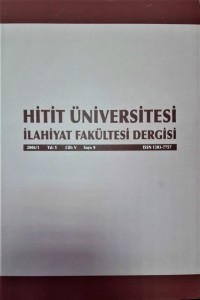Abstract
The claims of distortion in the Qur’an increased especially in the second half of the 3rd/9th century.
In this era, attempts to justify the thought that the person who would be the Imâm should be
determined exactly by the nass, also increased, and also Hasan al-Asqari (260/874), the eleventh
imam of the imâmate, died so the imâmate were in search of a new imâm. The claims of distortion
in the Qur’an which were especially asserted by Shî’a were criticized by Zaydiyya which was considered as a subset of Shî’a. In this context, al-Qâsim al-Rassi (246/860), attempted to prove the
integrity of the Qur’an by citing some verses of the Qur’an in which Allah ordered obedience to his
creatures. According to al-Qâsim al-Rassi those verses indicates logically to the integrity of the
Qur’an, because in order to act totally in obedience to Allah, there should be no deficiency in
Qur’anic commands, prohibitions and permissions. In his view, to ascribe the distortion of the
Qur’an to a follower of the prophet is also not acceptable, because while the prophet Muhammad
died there were a lot of believers who memorised the whole Qur’an or copied it by writing. Al-Rassi
also stated that he himself saw in the hand of a man, who belongs to sons of Hasan, a copy of the
Qur’an that was written by the handwriting of Ali bin Abû Tâlib, Salmân and al-Mikdâd, and he
declared that it was the same as the actual copy of the Qur’an. al-Hâdî ila al-Haq (298/910), who
took the subject more systematically and more detailed, mentioned consequences when it is accepted some parts of the Qur’anic text were lost, as a difference from al-Rassi. Hâdî ila al-Haq, by
citing the thaqalayn Hadith (Hadith of the two precious things) as an evidence, also declared it is
impossible that there was a distortion in the Qur’anic text.
Keywords
References
- Râgıb el-İsfehânî, el-Müfredât fî Garîbi’l-Kur’an, Kahraman Yay. , İstanbul 1986.
Abstract
Keywords
References
- Râgıb el-İsfehânî, el-Müfredât fî Garîbi’l-Kur’an, Kahraman Yay. , İstanbul 1986.
Details
| Primary Language | Turkish |
|---|---|
| Journal Section | Articles |
| Authors | |
| Publication Date | June 30, 2006 |
| Published in Issue | Year 2006 Volume: 5 Issue: 9 |



